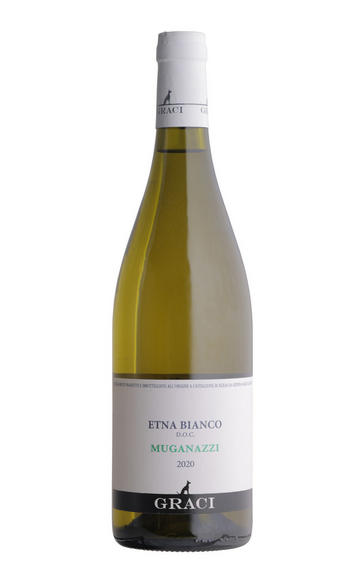
2020 Muganazzi, Etna Bianco, Graci, Sicily, Italy
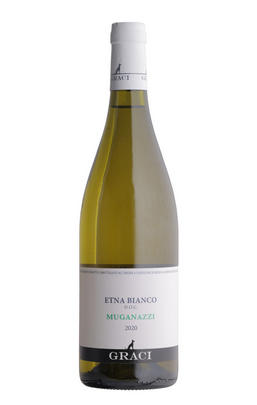
Critics reviews
The 2020 Etna Bianco Muganazzi holds my attention firm with a richly elegant mix of ripe peaches, cracked slate, cardamom and subtle nuances of lemony custard. It’s soft-textured and round in feel, coming across as almost oily at times, yet with a mineral and citrus-tinged core that keeps the wine wildly fresh. Lime zest, spice and almond paste linger incredibly long through the lightly structured finale. The palate is left remarkably refreshed and watering for more. If tasted blind, I may have called this new single-vineyard Carricante a village-level white Burgundy. What an exciting wine to taste.
I found the Etna Rossos from Graci among the top wines I tasted for this year's report. Especially the 2018 Arcuria Sopra il Pozzo, which transcends the conditions of this challenging year. The 2020 Rosso Arcuria and Rosso Feudo di Mezzo were equally compelling. However, I can’t say the same for the 2021 and 2022. In both cases, the wines come across as understated to a fault or mineral to the point of being fruit-challenged. When possible, I checked in on a second bottle, each time with the same result. For example, the 2021 Arcuria shows a Band-Aid note on the nose that leads me to suspect Brettanomyces.
Drink 2023 - 2027
Eric Guido, Vinous.com (September 2023)
Here's an exciting new addition to the Graci portfolio. The 2020 Etna Bianco Muganazzi (with just 2,800 bottles made) is all Carricante that sees both stainless steel and large oak cask. Muganazzi shows extra fruit weight and aromas of melon and stone fruit that add creaminess to the wine's medium-rich texture. It shows an interesting firmness on the close with prominent freshness.
Alberto Aiello Graci is one of the protagonists of the Etna wine movement. He has added a beautiful new white wine to his portfolio from the Contrada Mugnanazzi, which sits at 700 meters above sea level.
Drink 2023 - 2030
Monica Larner, Wine Advocate (June 2023)
Leesy and smoky notes on the nose, with papaya, pineapple and toffee. Medium-bodied, ripe and tropical, balanced by tangy acidity. Oily finish. Carricante.
Drink now
James Suckling, JamesSuckling.com (September 2022)
About this WINE
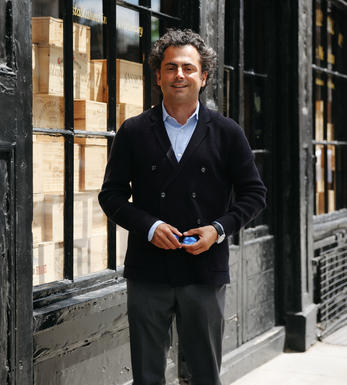
Graci, Sicily
Alberto Aiello Graci has been making wine on Sicily's Mount Etna since 2004, the year he returned from his apprenticeship as a Milan banker, picking up the baton with 5 hectares of family land, 2 hectares of which is vineyards (the rest polycultural activities).
The region of Etna Rosso, famous for its black lava soils and elegant red wines made from the Nerello Mascalese and Cappuccio grapes, has been undergoing a revival since 2000, lured by juicy EU grants and spectacular scenery. Once carpeted with vines - the fruit of which was allegedly used to in bulk to prop up the wines of the Langhe and of Burgundy - it has now become an artisan's playground, a mix of hobbyist and commercial winegrowers.
Alberto Graci is definitely in the latter category; his feet firmly on the ground. As the Vice President of the Consorzio, that covers 300 hectares of Etna DOC, he's forever preoccupied with the quality of the wines now being produced (at yields still as high as 65hl/ha).
His patch of heaven is part 50 year old, 8500 high density, free-standing 'alberello' vines at 1000 metres above sea level that produce naturally low yields amid the black grainy soils, part younger trained vines on flatter, lower sandier terra. He prefers to tend his vines as naturally as possible.
Fermentation takes place in a combination of large cement and Au strian Stockhinger oak of 42hl, at ambient (30-35 celsius) temperatures, using wild yeast, before moving the wine into slightly smaller Gamba barrels. He seeks the reductive quality of large oak, that captures the character of the soil and fruit, rather than the stylistic effects of micro-oxygenation brought by French barriques.
Alberto debuted his Etna Rosato (100% Nerello Mascalese) with the 2013 vintage, partnering the earlier drinking smoky red Etna Rosso, the more structured, wilder berried Quota 600 (from vines 600 metres up - a 500 case production of only Nerello Mascalese and Cappuccio, lush and lithe), the high thrills of his Quota 1000 and the minerally citrus Etna Bianco Contrada Arcuria (made from 100% Carricante).
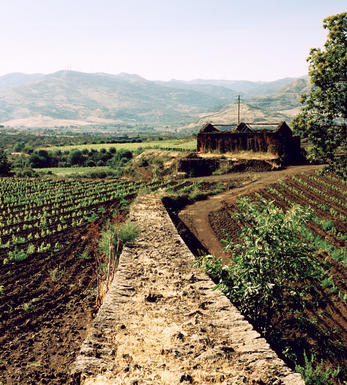
Etna
Winemaking on Mount Etna, located on the eastern coast of Sicily in Italy, is a unique and ancient tradition that has gained significant recognition in recent years. Etna is one of Europe’s most active volcanoes, and its volcanic soil, elevation, and climate combine to create exceptional conditions for grape cultivation and winemaking.
The volcanic soil is rich in minerals and nutrients, making it highly fertile for grapevines. The dark, volcanic ash and lava rock contribute to the unique flavor profiles of the wines, giving them a distinct mineral and earthy character.
Etna is a high-altitude wine region, with vineyards located at various elevations ranging from 1,300 to 3,300 feet (400 to 1,000 meters) above sea level. This elevation results in cooler temperatures, which help to preserve acidity and freshness in the grapes, even in the warm Mediterranean climate.
The dominant grape variety is Nerello Mascalese. Nerello Cappuccio, another red grape variety, and Carricante, a white grape variety, are also cultivated here. These grapes are well-suited to the volcanic soil and elevation, producing wines with complexity and elegance.
Etna has a diverse range of microclimates due to its varying elevations, exposure to the sun, and volcanic activity. These allow winemakers to produce a wide range of wine styles, from lighter, more elegant reds to fuller-bodied, age-worthy wines.
The region has a rich history of winemaking dating back thousands of years, but in recent decades, there has been a resurgence of interest in producing high-quality wines. Many winemakers combine traditional techniques with modern innovations to create exceptional wines.
The region has its own Denominazione di Origine Controllata (DOC) designation, which sets quality standards and regulations for winemaking. This designation helps protect the authenticity and quality of the wines.
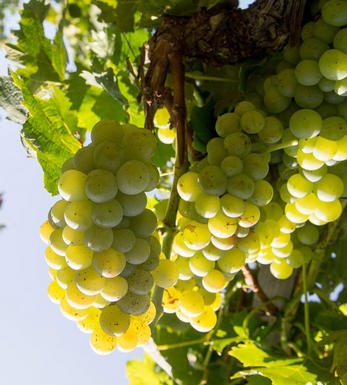
Carricante
Carricante is one of the most important and traditional grape varieties used to produce white wines in Sicily, Italy. It's known for its crisp acidity, minerality, and delicate aromas, making it a favourite among enthusiasts who appreciate lighter, refreshing styles of white wine.
The variety is believed to be native to the volcanic slopes of Mount Etna in northeastern Sicily. This region's unique volcanic soils and high-altitude vineyards play a significant role in shaping the grape's character and contributing to the distinctiveness of the wines.
The vines are known for their adaptability and are particularly well-suited to the volcanic ash and lava-rich soils, which help impart a pronounced mineral quality to the resulting wines.
Carricante wines are typically characterised by their bright acidity, subtle fruit flavours, and mineral-driven taste. Typical flavour notes include citrus (lemon, lime), green apple, pear, and sometimes hints of floral and herbal nuances. The volcanic influence often contributes to smoky and stony undertones in the wine.
While the wines are generally consumed young to appreciate their fresh and vibrant character, some producers also make versions suitable for ageing. Proper cellaring allows these wines to develop more complex flavours and evolve gracefully.
The variety's bright acidity and fresh fruit flavours make them excellent companions for various dishes. They pair well with seafood, especially shellfish, grilled fish, and light pasta dishes. The wines' mineral character also makes them an excellent match for dishes with volcanic soil-infused ingredients, such as certain types of cheese and vegetables grown in volcanic regions.


Buying options
Add to wishlist
Description
Fermented in both concrete vats and botti (large neutral oak barrels), this fabulous Carricante wine has a beautiful fragrant bouquet of flowers and fresh cut fruit. Fabulous on the palate with rich fleshy fruit, minerality from the volcanic soils and floral notes, ripe with zippy acidity. This is a delicious wine that will show well in its youth but has the capacity to age for 5 years or more.
Drink 2023 - 2028
Chris Pollington, Senior Account Manager, Berry Bros. & Rudd
wine at a glance
Delivery and quality guarantee